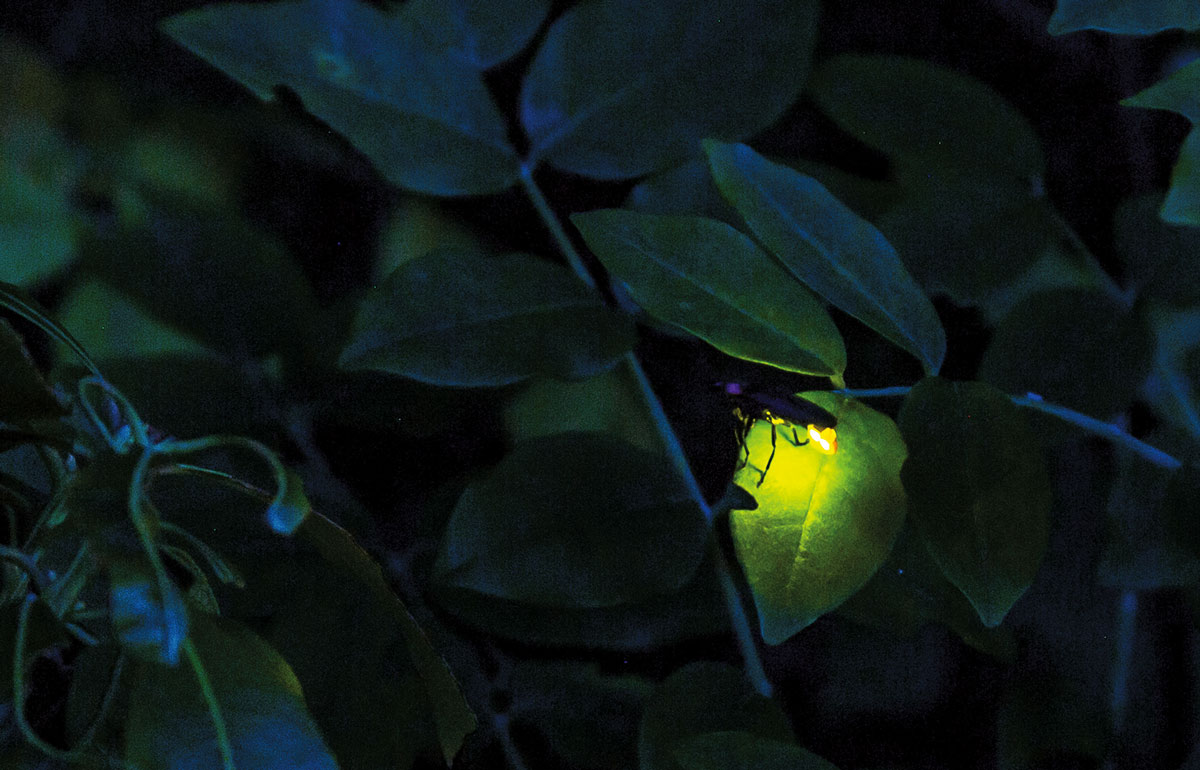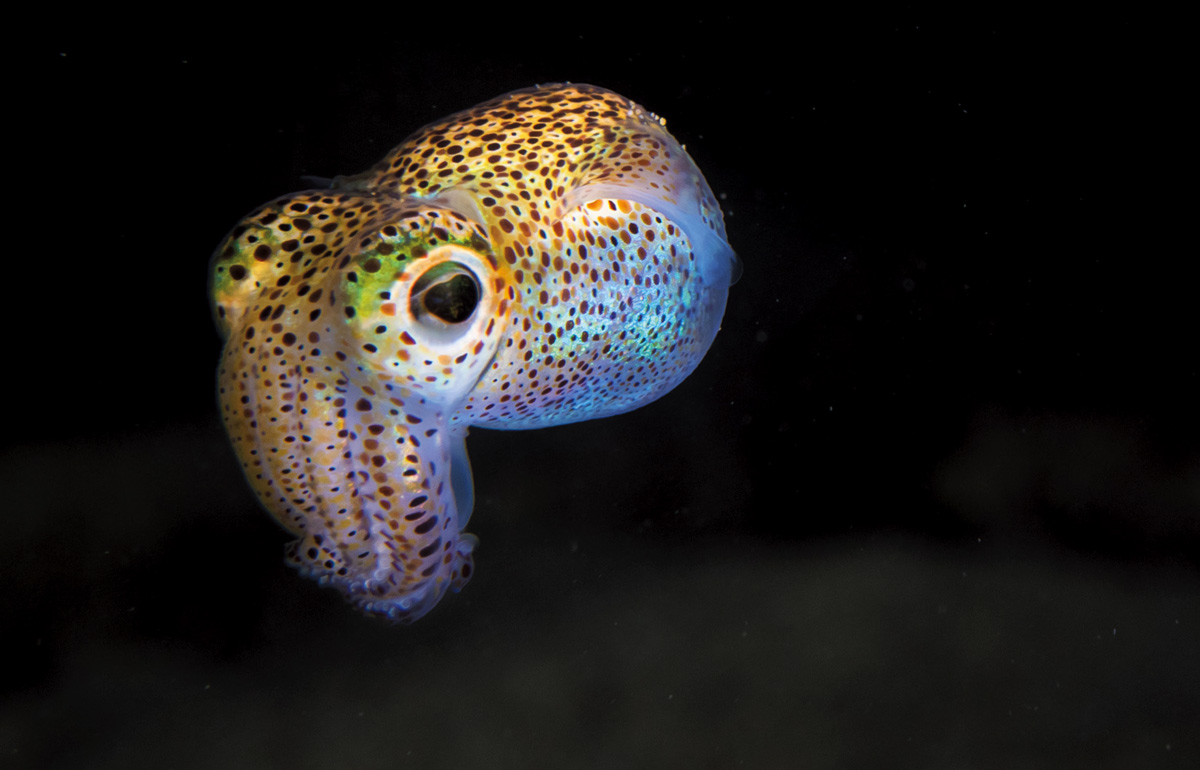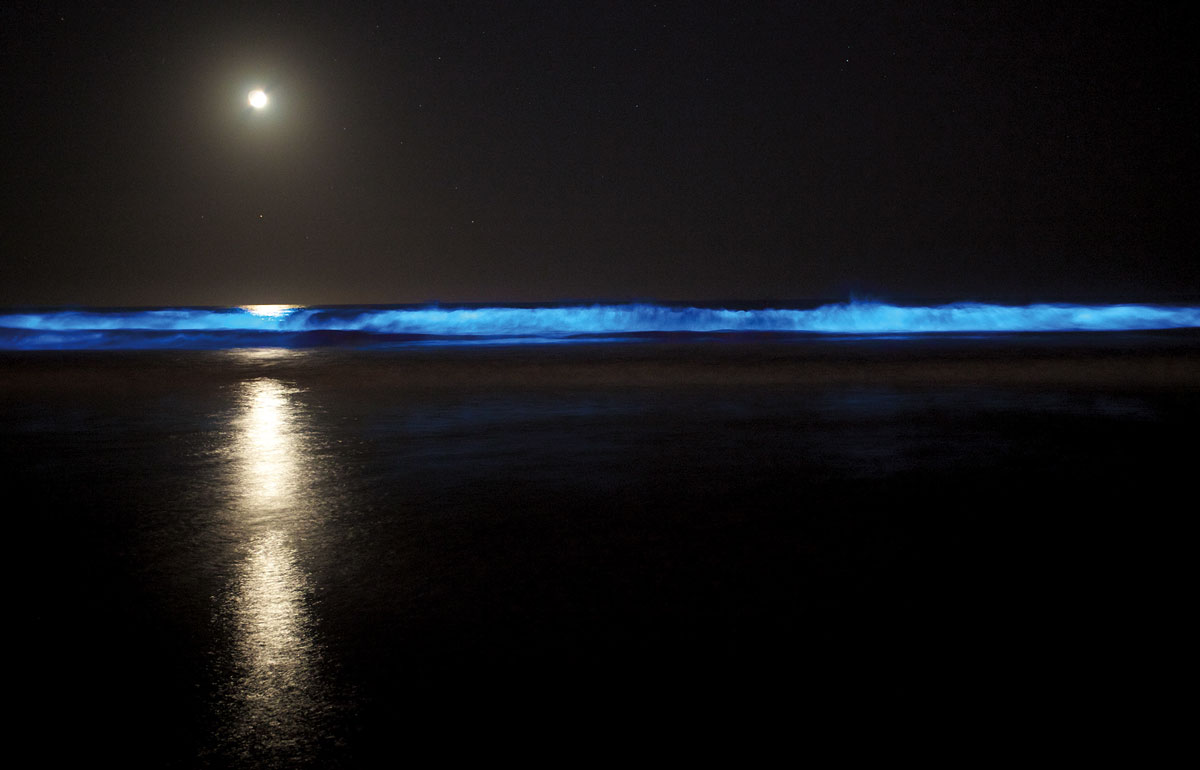I’m lying on the deck of the Songbird after a day’s diving in Lake Powell, staring up through the thin, high altitude atmosphere. Never has the night sky looked so stunning. I’m mesmerized by the shimmering brilliance of the heavens, struck by an unmistakable sense of solace and wonder. As humans, we are drawn to light — the flying sparks of a campfire, the warm colors of a rising or setting sun, the romantic radiance of the moon and the pinpricks of light that decorate the night skies. But just as mesmerizing, and perhaps more stunning and surprising, is the seemingly unearthly glow that splits the darkness of the deep. Like the twinkling glitter of distant galaxies in the ink-black heavens, the deep-sea world, void of sunlight, is alive with a glow created by the creatures that inhabit the darkness below.
Bio-light Basics
The warmth and radiance of sunlight is something that we all enjoy, but we might not recognize that it comes from a natural nuclear fusion reaction. Under unfathomable pressure, the nuclei of hydrogen atoms fuse together to create a new element — helium. The reaction releases unimaginable light as well as thermal energy — the temperature of this reaction exceeding ten thousand degrees Fahrenheit. For the most part, the essence and drive of life on Earth comes from the energy of the sun’s light. Plants capture the photonic energy of sunlight — harnessing it through the complex chemistry of photosynthesis.
Another form of light energy — the cool light of bioluminescence — is derived from other complex chemical reactions. Japanese-born Osamu Shimomura, a professor of chemistry at Woods Hole Oceanographic Institute in Woods Hole, Massachusetts received the Nobel Prize in 2008 for identifying a chemical compound called green fluorescent protein (GFP) in a jellyfish (Aequorea victoria). As it turns out, GFP reacts with another protein — aequorin — to emit a blue light in the presence of calcium. While Shimomura’s work with bioluminescence, which began in the early 1960s, has been important in medical research, the basics of life creating light beneath the seas continues to be an important area of marine research.
The GFP-aequorin reaction is not the only bio-chemical reaction for creating bioluminescence. Perhaps more common is that which relies on a molecule called luciferin, which generates light when it reacts with oxygen. In many cases, a catalyst enzyme — luciferase — is part of the chemical reaction that speeds the process. But there are many different types of luciferin that have developed in a variety of different species. Some organisms combine the luciferin and oxygen in a compound called a “photoprotein” that ignites in the presence of calcium ions. Thus, the release of calcium ions within the organism controls the reaction.
Not surprisingly, organisms can control the generation of light by regulating their brain processes to control the chemistry. As it turns out, there are many versions of bioluminescence and many species that exhibit bioluminescence can control both the intensity and color of the light they produce.

Probably the first thing we think of when we hear bioluminescence is fireflies in a forest. But bioluminescence is also found in a surprisingly vast array of marine life, including cephalopods, crustaceans and even sharks.
Bioluminescence is A Surprisingly Common Theme
The first time I encountered bioluminescence in the ocean, I thought I had stumbled onto a rare phenomenon. With my dive light covered, I found myself immersed in a world of fairy dust: the surface of each exhaled bubble illuminated with sparkling light and trails of twinkling light blossomed in the wake of my every move. It was stunning, but I soon learned that the ability to create light was more common than many might think.
Probably the first thing we think of when we hear the word bioluminescence is fireflies — those fanciful sparks of light that flit about on a warm summer’s evening. For those who spend time on the water, an equally common form of bioluminescence is the glowing wake of a boat created by tiny dinoflagellates that emit their captivating glow when the water is disturbed by motion.
Bioluminescence is found in a surprisingly vast array of marine life, including everything from bacteria, algae and jellyfish, to worms, crustaceans, fish and sharks. In fact, some 1,500 species of fish alone are endowed with the power to create light. If you haven’t seen bioluminescence firsthand underwater, you might wonder where to go to witness this phenomenon.
A few areas are famous for their abundance of bioluminescence. Several bays in Puerto Rico are well-known and frequently visited destinations for those seeking a fact-to-face encounter with bioluminescence. The waters in these bays are teeming with microscopic dinoflagellates, which emit their glow when the water is mechanically disturbed. Other areas where this phenomenon is commonly seen include Luminous Lagoon in Jamaica and Halong Bay in Vietnam and in mangrove lagoons in the Cayman Islands. While these areas might be famous for their abundance of glowing marine organisms, bioluminescent species are found around the globe, in all the world’s oceans, and from surface waters to the murky depths. It isn’t all for show. The multitudes of light-producing species have adapted their bioluminescent capabilities to serve a broad array of purposes.
Communication
Few divers have ever seen a lantern fish while underwater, but these just might be one of the most common fish in the world’s oceans. They are small — typically under 6 inches (15 cm) long — but plentiful, with a global biomass estimated between 600 and 725 tons (550 to 660 Mg) — roughly 65 percent of all deep-sea fish biomass on the planet. The reason we don’t usually see them is that they spend their days at depths from 1,000 to 5,000 feet (300 to 1,500 m). But at night, they rise to the shallows, scouring the depths between 30 and 300 feet (9 m and 91 m) in search of the zooplankton on which they feed.
As the name might imply, lanternfish are among those with bioluminescent abilities. They are adorned with paired rows of light-producing organs — photophores — on their heads and bellies. Some have them next to their eyes, and adjacent to their fins. These photophores emit a weak yellow, blue or green light believed to be used as a form of communication. In some species, the male and female have different patterns, but each species of lantern fish — there are some 200 species — seem to have their own unique pattern of lighting, allowing them to discern one another. And the patterns of their flashing photophores are thought to be a code perhaps known only to themselves.
Bioluminescence: The Glow of Love
One realm in which bioluminescence casts its glow is in sexual courtship — seeking a mate — and a variety of sea life uses bioluminescence in some surprising ways in an underwater dating game. Syllid fireworms are a type of small polychaete worm — typically no more than 5 inches (12.7 cm) in length. They spend most of their time buried in mucus tubes on the sea floor, eating coral, anemones and crustaceans. But when it’s time to mate, a few days after a full moon in the early darkness before the moon rises, they head for the surface for a “moon dance.” The females head for the surface first, turning on their bioluminescent glow and swimming in crazy small circles to attract a mate. Apparently, it works pretty well. The males, also glowing, shoot up from the seabed like skyrockets to meet the females. A frenzy ensues in which both males and females spill their gametes into the sea, a shimmering display celebrating the rising moon and the continuance of life.
Other species have their own illuminated reproduction rituals. The Caribbean ostracod is tiny bioluminescent crustacean that lives among the shallow sea grass and coral reefs. You might not even notice them in the daylight but, at certain times during the night, they put on a light show worthy of a Superbowl half-time. In a game of subsea seduction called the “string of pearls phenomenon,” the male ostracod lays out a suspended string of glowing mucus globs. Recognizing the precise spacing of the bioluminescent blobs, the female follows the luminous line, knowing that her prince charming lies in wait at its end. Who knew crustaceans could be so romantic? (Many dive operators in Bonaire know — they offer special guided “ostracod night dives.” The dives must be timed after the full moon and operate on a weather-permitted schedule, so ask about it.)
The firefly squid also has a mating ritual, which typically occurs between February and July. At these times, they gather in great numbers to spawn. During the event, squids will light up their entire body to attract a mate. But sadly, it is their last crazy last glowfest. Once the squid’s eggs have been laid and fertilized, the squid dies, having reached the end of its one-year lifespan. Others will soon take their place and the circle of life for the firefly squid continues.

Bobtail squid have a symbiotic relationship with bioluminescent bacteria, which inhabit a special light organ in the squid’s mantle.
Illuminated Invisibility
Survival of a species (or an individual) often relies on the ability to hide one’s self from attackers. So, imagine how vulnerable a shrimp might be when viewed from below on a sunlit afternoon. The shrimp’s silhouette would be unmistakable and irresistible to predators in the darkness below. One strategy for survival is to avoid swimming near the surface during daylight hours. But some shrimp have developed a different approach. Using bioluminescence, the Sergestes similis can illuminate their bellies to match the intensity of light above them — effectively creating a cloak of invisibility. This cloak can be turned on and off, and its intensity changed to maintain the shrimp’s camouflage as light levels at the surface change throughout the day. But this bright little shrimp isn’t the only sea creature to take advantage of this countershading strategy. According to a study performed by researchers at Scripps Oceanographic Institute in La Jolla, California, many mid-ocean fish and squid also use this bioluminescent cloaking strategy to camouflage their movements.
Another example is the firefly squid (Watasenia scintillans) — a 3-inch (7.6 cm) squid found in the Western Pacific at depths of 600 to 1,200 feet (183 to 366 meters). The firefly squid’s head, mantle, and tentacles are dotted with photophores. Like the Sergestes similis, the “firefly squid” or “sparkling enope squid,” can light up its entire body to match the illumination from above, making it nearly impossible to detect from below. But the firefly squid’s bioluminescence serves another purpose as well. The photophores can also flash and the flashing light attracts tiny fish on which the squid feeds.
A Tantalizing Trap
Few of us, if any, will ever encounter a viperfish (Chauliodus sloani) while exploring the depths, and that might be a good thing. Images of these 12- to 24-inch (30 to 61 cm) long fish reveal sheer horror, the likes of which seem to come right out of the pages of science fiction. With a hinged lower jaw and long, needle shaped teeth, the viperfish probably does well to remain in the dark. Lurking at depths of up to 9,000 feet (2,800 meters) in tropical and temperate waters around the world, they attract shrimp, squid, hermit crabs, anchovies, mackerel and other small fish using their luminescent “photophores” along the sides of their bodies, and a glowing lure that dangles above their head near their mouth. When prey comes within striking range, they lunge at high speed and impale them on those razor-sharp teeth.
Equally as unattractive, but much smaller, the black seadevil (Melanocetus) uses a similar strategy, dangling a bioluminescent bulb from a spine on top of its head to lure unsuspecting prey into striking range. This deep-sea dweller is only 7 inches (18 cm) in length (the males are only 1-inch [2.5 cm] long) and is found in tropical to temperate waters of the Atlantic, Pacific, Indian and Pacific oceans, with one species found in the Ross Sea of Antarctica.
Hide and Seek in the Deep
Strategies for capturing food are fundamental to life and survival, and this fundamental need sets the stage for another application of bioluminescence. The flashlight fish — the common name for three similar families of fish — uses just such a strategy. A shallow water fish found on coral reefs and rocky outcrops throughout the Pacific Ocean and in the eastern Indian Ocean, the flashlight fish is equipped with bizarre light-emitting organs located beneath each eye. Muscular skin flaps allow the flashlight fish to cover up those organs when not in use. Researchers believe the flashlight fish uses these “headlights” at night to help find their planktonic prey.
Other species have taken the concept of night vision to a whole new depth. As divers, we know all too well how light is absorbed by water. The brilliant colors we see in the shallows fade to blue as we descend, the warmer reds disappearing first as these long wavelengths of are absorbed. So, imagine what we might see if we could shine a red light at depth. Suddenly, things might appear that we never saw or imagined before.
The dragonfish (Malacosteus) is a family of fish that has developed precisely that ability, along with the ability to see red light — a capability lacking in most deep-sea species. In addition to producing the “typical” blue-green bio-light, the dragonfish has unique light-producing photophores that create a red, near-infrared light that can be used to illuminate the depths. This allows them to illuminate red-colored prey and, as researchers tell us, they can even use that light to point prey out to other dragonfish without alarming the prey.
The way that the dragonfish can perceive the red light is itself a remarkable feat of biology, using a “reverse fluorescence” process. The red light is absorbed by a special molecule in the dragonfish’s visual pigments that converts the energy of the red light into a normal blue-green wavelength that can be seen. And here is the amazing part: that special molecule is a derivative of chlorophyll — the molecule that captures sunlight in plants and converts it to a useable form.
Symbiosis in the Sea
The ability to create light is not necessarily one that all bioluminescent species are born with. For some, it is one they acquire through a symbiotic relationship with true bioluminescent species. A good example is the Hawaiian bobtail squid (Euprymna scolopes). These amazing creatures have a special light organ in their mantle that becomes colonized with bioluminescent bacteria within hours of hatching.
The way this happens is truly remarkable. The newly hatched squid uses its gill ventilation to draw in seawater, pass it through the mantle cavity and harvest the symbiont bacteria. The cavity is lined with specialized cells equipped with hair-like structures called cilia. These cells secrete a mucus that captures bacteria, which the cilia then pushes through a ductwork into “crypt spaces.” A certain type of bacteria (V. fischeri) is captured by the mucus and carried into the crypt space where it undergoes a harsh oxidation process that seemingly only the V. fischeri can survive. This all happens in a matter of hours, but over the next four to five days, a transformation occurs. The bacteria trigger a transition of the crypt spaces into a functional light organ. In the process, the entire bacteria-harvesting mechanism dies off and the colonization by the bacteria is complete and irreversible.
So, it seems that our attraction to light is not unique and is perhaps a common theme that connects many species in a myriad of ways. Light is perhaps the most important form of energy for life, and although the sun is the powerhouse that propels most life on this planet, the softer glow of bioluminescence is a fine-tuned element critical for survival in the sea. It truly is a beautiful sight.
 Bioluminescence: A Dangerous Glow
Bioluminescence: A Dangerous Glow
We don’t normally associate bioluminescence with environmental hazards, but in some cases, they do go hand in hand. For example, some species of bioluminescent dinoflagellates can be associated with red tide. In low concentration, these creatures are harmless, but under the right conditions, they can reproduce rapidly, multiplying in great numbers to create toxic red tide conditions.
Another bioluminescent species, the carnivorous sea sparkle (Noctiluca scintillans), excretes ammonia as a by-product. The ammonia is harmful to some species and can result in algae blooms in other species.






